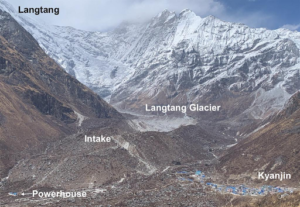In news– Nepal’s first hydropower project from a glacial lake has become functional recently.
About the project–
- It was built three years after the 2015 earthquake-avalanche that devastated the valley, with help from the Hong Kong-based Kadoorie Charitable Foundation.
- The $534,000 scheme has a weir and spillway at the moraine, and the water is taken through a fiberglass-insulated penstock pipe to a powerhouse that generates 100kW of electricity.
- It provides 24 hours of electricity to 120 households and tourist lodges in Kyanjin and Langtang.
- Langtang Lirung Glacier lake at 4,100m is being drained to lower its level, and the water is used to generate electricity.

- The project is a first-of-its-kind in Nepal to power a village, and holds promise for other remote Himalayan valleys where the risk posed by expanding glacial lakes can be mitigated.
- Micro hydro is a type of hydroelectric power that typically produces from 5 kW to 100 kW of electricity using the natural flow of water.
Similar projects–
- There are other dangerous glacial lakes in Nepal like Imja in the Everest region and Tso Rolpa in Rolwaling Valley, where the water level has been lowered at enormous cost, but the schemes have not added the hydropower component.
- Imja was financed by the UNDP with funding from the Global Environment Facility, while Tso Rolpa was funded by the Dutch government.
- Glacial lakes have been used to generate power in the Peruvian Andes, and in the Swiss Alps existing reservoirs filled with glacial melt have been generating 4% more electricity because of accelerated melting.
What is a glacial lake?
It is a body of water with origins from glacier activity. They are formed when a glacier erodes the land, and then melts, filling the depression created by the glacier.
What is glacial moraine?
A moraine is any accumulation of unconsolidated debris, sometimes referred to as glacial till, that occurs in both currently and formerly glaciated regions, and that has been previously carried along by a glacier or ice sheet.
















